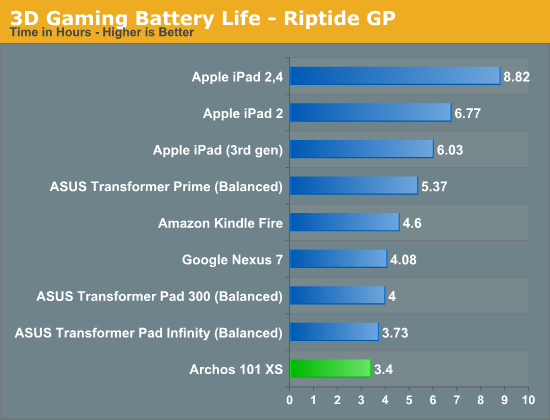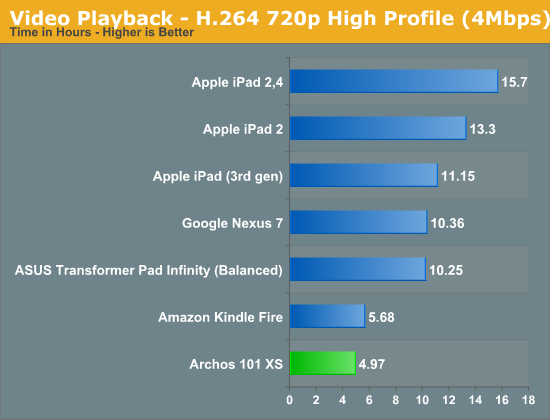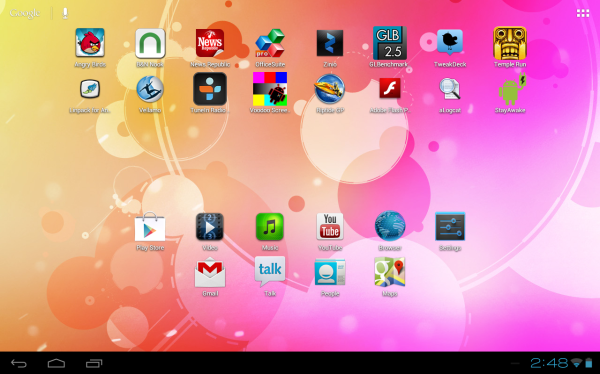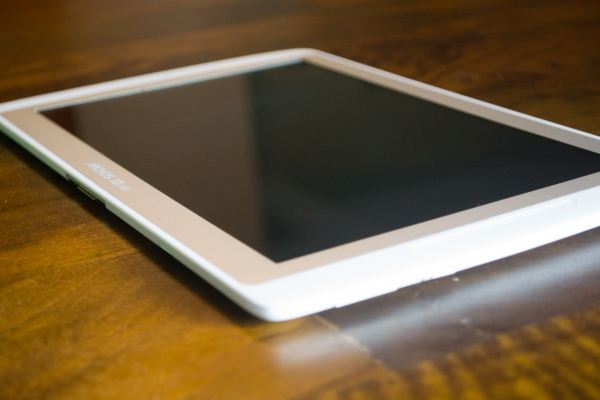The Archos 101 XS Review: Prettier, Faster, So Much Better
by Jason Inofuentes on August 22, 2012 12:15 PM ESTSoftware
Archos has taken an approach to software development that has favored performance by leveraging every hardware advantage possible, and ignoring the urge to muddy the UI with their own skins and widgets. This we knew from their G9s and that persists in the XS. During our interviews with the Archos team leading up to our G9 reviews we also learned that they were committed to maintaining software parity with the G9s even well after successor devices had been released. The release of Jelly Bean has put that promise in a bit of jeopardy but, what we do know is that Archos will still aim for software feature parity across the two lines. That’s not to say they aren’t going to try to get Jelly Bean onto the G9s, simply that their first priority must be to get Jelly Bean optimized for the XS, and then they’ll set their resources onto the G9 build.
I’m hopeful, though. The decision to remain on OMAP 4 has the benefit of being able to use unified source code from which the G9 and XS firmwares are derived. So, once the XS Jelly Bean build is completed, the delta from that to a G9 optimized version of Jelly Bean is much smaller than if the two devices were running entirely different architectures. But even if Jelly Bean doesn’t make an appearance on the G9, Archos remains committed to bringing any optimizations from their Jelly Bean source that could benefit the G9 over to their ICS builds.
As to when that Jelly Bean build for the XS is going to happen . . . Well, it’s not clear, but Archos is hopeful that it could be sometime this fall, which is pretty aggressive considering how late in the summer the XS is being released. As soon as we have an update from Archos on that we’ll pass it on.

As far as this ICS build, well, it is actually a pre-release build and in some ways that shows. Archos has been dinged in the past for some issues with touch performance, and that seems to persist. There’s a significant component of that issue which is due to the hardware, but with the hardware finalized the only way to see any improvement in it is through software updates. Otherwise the UI and software is just like the current firmware for the G9s, with a stock UI and a custom media suite. The massive codec support that impressed us in the G9 remains intact, though that support does not extend to the stock player, only Archos 's own player. This does lead to some curious issues where a particular file won’t play on the Archos player, but plays just fine under the stock player. We’re not sure why the disparity, but so far we haven’t run into a common codec combination that wouldn’t play in either player, so most of your ripped content should playback just fine.
Battery Life
The bulk of the volume and weight of a given tablet is usually the battery. This is certainly true for the Archos 101 XS, whose slim frame is filled with a 25 Whr battery, matching the Transformer Prime, and nearly 10 Whr bigger than the Nexus 7. Like performance, though, battery life owes as much to the software, as it does to the hardware.
Our first test is typically the web browsing test, which cycles through 20 common webpages and tries to foil any caching strategies too ensure that the appropriate radios are activating. Unfortunately, with this pre-release software we encountered some browser instability during testing. We didn’t have any issues with the browser during day to day use, and we’ll update the review once we have a software build that resolves this issue. So, we’ll move on.

The 3D Gaming test is a new one, but one that should give an accurate estimation of the amount of time you can expect to spend playing an graphics intensive game on a given tablet. And things don’t look great for the 101 XS. The OMAP 4470 remains a 45 nm part, so there’s no rewards netted over the prior generation Archos tablets from a process switch. The SGX544 not only retains the higher clock speeds of the SGX540 in the OMAP 4460 (384 Mhz) but it also adds components, so the resulting increase in performance comes at the cost of playtime. It’s not necessarily a bad trade off, as performance is significantly better.

Our video rundown test has been updated, and involves the simple act of looping a movie with the brightness set to 200 nits. In talking to Archos, their testing put this test in the vicinity of 6+ hours; the difference being that they test at 150 nits of brightness to our 200 nits. The bright side of their result is that there are power savings to be gained in lowering the brightness if you can stand it. Otherwise, keep a charger handy.
It's notable that several of the tablets in these charts have 10.1" displays backed by ~25 Whr batteries, so this isn't an issue of battery size. Archos has squeezed a lot of battery into a thin frame. The component power cost is just too high. The display may be inefficient, or the SoC not so quick to spool down, but the video test may point to a bigger issue. Like most modern SoCs TI's OMAP 4 architecture includes explicit video decode IP so that no AP or GPU cycles are used for video playback. The AP and GPU may remain active to handle background tasks or draw UI components for the video player, but even some of that should be handled by the low-power Cortex-M3 cores and the Composition GPU. It's likely that the aggressive governor set by Archos to ensure performance goals is keeping things spooled up a little more than necessary. ASUS' approach has been to offer user controllable governors, and it's an approach that could pay off for Archos, as well.












44 Comments
View All Comments
aryonoco - Wednesday, August 22, 2012 - link
Hi Jason,Fine article, but there were a few grammatical errors in your piece that shouldn't have gone beyond your editor:
"the kind of codec support that many of todays popular tablets" should be "today's popular tablets".
"Archos has worked to tweak there Android" should be "their Android"
"does not extend to the stock player, only Archos own player" should either be "Archos' own player" or "Archos's own player" (depending on which style guide you follow).
Thanks
JasonInofuentes - Thursday, August 23, 2012 - link
Missed a few others, yourself. I'll try and catch the rest before you do. Cheers.Jason
rarson - Wednesday, August 22, 2012 - link
in the AnandTech comments section.JasonInofuentes - Thursday, August 23, 2012 - link
If any of you guys are professional commenters let me know. :)Charbax - Wednesday, August 22, 2012 - link
Archos 101 XS with keyboard: $399Asus Transformer Pad TF300 with keyboard: $529 (+33%)
Acer Iconia Tab A700 with keyboard: $599 (+50%)
Asus Transformer Prime with keyboard: $649 (+63%)
iPad3 with keyboard: $599 (+50%)
Samsung Galaxy Note 10.1 with keyboard: $599 (+50%)
Microsoft Surface with keyboard: $599 (likely) (+50%)
I think Archos likely will release a firmware to fix the power consumption for video and games. Also consider video games need to be fully optimized for SGX544 before they can perform as well as for example on Tegra3. This is likely happening faster than some would think, I think OMAP4470 is going to win Q4 2012 just as OMAP4430/4460 won Q4 2011 (Galaxy Nexus, Kindle Fire, Nook Tablet, Motorola Razr/Atrix2 etc..) I expect OMAP4470 is the platform in upcoming Galaxy Nexus Superior, Kindle Fire 2, likely also the next range of Motorola, LG and some other Samsung devices among other. The more devices means the better software optimizations Archos can automatically get for Android features also. OMAP4 pretty much is the reference design for ICS and JB, this is likely to continue even as Google "opens up" to all other SoCs and manufacturers with the PDK.
voss,seal - Thursday, August 23, 2012 - link
I followed your "advice" on the previous Archos model. So I bought it, I'm in the process of returning my third Archos 101 - in a period of four months - because of touchscreen failures. I'd rather pay more for a functioning tablet.JasonInofuentes - Thursday, August 23, 2012 - link
I'm truly sorry you had a bad experience with the G9s. There's one thing that's much harder for us to report on than simply discussing our experiences with a given device: longterm durability. Build quality is a hurdle that Archos has to address, along with improving the turn around time for repairs or replacements.I think one issue is that very few of these devices end up our daily drivers, even if the review samples stay with us for a while so that we can follow up on software updates. Part of that, is that many of us don't have a reason to have a daily driver tablet. Readers that have followed our iPad coverage probably recall that almost every review features a section bemoaning the extent to which the prior generation has remained in a drawer, unused. The tablet isn't yet an essential device. It's nice to have, and I enjoy using whatever I have on hand to watch videos and play the occasional game. But it's not part of my daily life.
In the meanwhile, I do apologize you've had as much trouble with failures. In the future, whether we recommended it to you or not, please let us know when a product you've bought has hit 'lemon' status. We appreciate the feed back.
Jason
Charbax - Friday, August 24, 2012 - link
I don't know what kind of problem voss thinks he has had. I've been using Tablets nearly every single day since February 2005. Initially the 3.5" Archos PMA400 with Qtopia Linux apps and WiFi tethering then already. Then other and only Archos devices with few Chinese cheap tablets to test. Since September 2010, every day I use the Archos 70 Internet Tablet when I go outside, it fits my jacket pocket. I upgraded it to Archos 70b Internet Tablet in January and I've been testing a few ICS soon Jelly Bean $50 tablets from Shenzhen since April, of course all those are 7" or smaller so that I can bring them with me every time I go outside, use them every time I'm in a bus or train or airplane, the 7" Tablet is just so much better than a phone size as it fits 2x to 3x more screen surface area, better for web browsing, better for apps, games, video playback (catching up all recorded/downloaded TV to not have to watch TV only at home) etc. This Archos 101 XS I think may allow me to use 10.1" for the first time as a laptop replacement. I could have spent $830 on a Transformer Prime with keyboard and Fry's Taxes in Las Vegas 8 months ago, but I did not want to pay that much, I thought it totally ridiculous to pay that much for an ARM Powered Laptop, those aren't supposed to cost nearly as much as an Ultrabook. I even think $400 for Archos 101 XS is still expensive, but when you compare with the competition, it's 33% to 63% cheaper. Sure enough, at $299 with keyboard I think the Archos 101 XS should be a huge fenomenon and everyone considering a 10" tablet or netbook/ultrabook should then consider it. Especially if/when Android gets optimized for Laptop/Desktop use, with some new "Desktop Mode" in Android, perhaps Google should just release such a Home Replacement that re-arranges things a bit optimized for Laptop Productivity, re-optimizing Chrome on Android just a bit so it's exactly like Chrome on any Laptop/Desktop, and also an app like Ubuntu on Android would be awesome for productivity. I'm waiting to see if Archos and TI can fix the governors to make sure battery life on its 6000mAh battery really is above 10 hours. And I'm looking forward to see if I can use Archos 101 XS to replace my $1000 Toshiba z830 ultrabook for most of my on-the-move Laptop productivity usage.tbutler - Friday, August 24, 2012 - link
I'm also concerned about build quality; the one other review I've seen on the 101 XS so far (the Verge one) cited significant issues there, especially with the screen. From the description, it sounded like they didn't use enough protection for the LCD panel, so you get typical LCD-pressure distortions when you put pressure on the screen from the front *or* back. Doesn't sound too encouraging to me.Spunjji - Thursday, August 23, 2012 - link
If OMAP4 is the reference for JB, why was the first JB device based on Tegra 3?The likelihood of a Q4 "win" for it looks unlikely given the probable arrival of at least one A15-based device by then, alongside proper SnapDragon S4 quad-core devices.